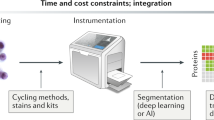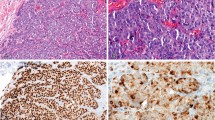Abstract
The practice of clinical cytopathology is characterized by the daily challenges of trying to establish pathological diagnoses on the basis of microscopic evaluation of small cellular samples, from both deep-seated and superficial anatomic sites. The diagnostic work-up of mass lesions involves a collaborative effort between clinicians and pathologists, and relies on the pathologist's ability to establish a reliable diagnosis; that is, one that convincingly explains the mass and its underlying neoplastic or non-neoplastic nature. Arriving at a conclusive pathological diagnosis is not always easy and additional ancillary tests, such as special stains, microbiologic cultures and flow cytometry, are often required. To ensure that clinicians can make appropriate management decisions, it is essential that pathologists use conventionally accepted diagnostic nomenclature and communicate effectively with their clinical colleagues. Clinicians should also ensure that the pathologist is provided with all relevant clinical information, preferably at the time of submission of the specimen. Clinicians should consult with the pathologist before the biopsy procedure, and inform them of the clinical differential diagnoses, to ensure that the proper ancillary tests are obtained for definite diagnosis.
This is a preview of subscription content, access via your institution
Access options
Subscribe to this journal
Receive 12 print issues and online access
$209.00 per year
only $17.42 per issue
Buy this article
- Purchase on Springer Link
- Instant access to full article PDF
Prices may be subject to local taxes which are calculated during checkout



Similar content being viewed by others
References
Kaminsky DB (1984) Aspiration biopsy in the context of the new Medicare fiscal policy. Acta Cytol 28: 333–337
Logroño R et al. (1998) Multidisciplinary approach to deep-seated lesions requiring radiologically-guided fine-needle aspiration. Diagn Cytopathol 18: 338–342
Rimm DL et al. (1997) Comparison of the costs of fine-needle aspiration and open surgical biopsy as methods for obtaining a pathological diagnosis. Cancer (Cancer Cytopathol) 81: 51–56
Suen KC et al. (1997) Guidelines of the Papanicolaou Society of Cytopathology for fine-needle aspiration procedure and reporting. The Papanicolaou Society of Cytopathology Task Force on Standards of Practice. Mod Pathol 10: 739–747
Oertel YC (1987) Fine Needle Aspiration of the Breast, 15–29 Boston: Butterworths
Bottles K et al. (1986) Fine needle aspiration biopsy: has its time come? Am J Med 81: 525–531
Franzen S and Zajicek J (1968) Aspiration biopsy in diagnosis of palpable lesions of the breast. Acta Radiol 7: 241–262
Lee KR (1987) Fine-needle aspiration biopsy of breast: importance of aspirator. Acta Cytol 31: 281–284
Stanley MW (1990) Who should perform fine-needle aspiration biopsy? Diagn Cytopathol 6: 215–217
Coghill SB and Brown LA (1995) Why pathologists should take needle aspiration specimens [editorial]. Cytopathology 6: 1–4
Oertel YC (2004) Emerging role of the interventional pathologist [editorial]. Diagn Cytopathol 30: 295–296
Grohs HK (1988) The interventional cytopathologist: a new clinician/pathologist hybrid. Am J Clin Pathol 90: 351–354
Logroño R and Waxman I (2001) Interactive role of the cytopathologist in EUS-guided fine needle aspiration: an efficient approach. Gastrointest Endosc 54: 485–490
Liu K et al. (1998) Fine-needle aspiration: comparison of smear, Cytospin, and cell block preparations in diagnostic and cost effectiveness. Diagn Cytopathol 19: 70–74
Nadji M et al. (1994) Immunocytochemistry in contemporary cytology: the technique and its application. Lab Med 25: 502–508
Bigner SH and Cohen CG (1991) Cytopathology during the 1980s. Am J Clin Pathol 96 (Suppl 1): S15–S19
Cortese C et al. (2004) Nongynecologic cytology practice guideline. Cytopathology Practice Committee, American Society of Cytopathology. Acta Cytol 48: 521–546
Yang GCH and Alvarez II (1995) Ultrafast Papanicolaou stain: an alternative preparation for fine needle aspiration cytology. Acta Cytol 39: 55–60
Layfield LJ et al. (2001) Immediate on-site interpretation of fine-needle aspiration smears: a cost and compensation analysis. Cancer (Cancer Cytopathol) 93: 319–322
Nasuti JF et al. (2002) Diagnostic value and cost-effectiveness of on-site evaluation of fine needle aspiration specimens: review of 5,688 cases. Diagn Cytopathol 27: 1–4
Eloubeidi MA et al. (2003) Yield of endoscopic ultrasound-guided fine-needle aspiration biopsy in patients with suspected pancreatic carcinoma: emphasis on atypical, suspicious, and false-negative aspirates. Cancer (Cancer Cytopathol) 99: 285–292
Afify AM et al. (2003) Endoscopic ultrasound-guided fine needle aspiration of the pancreas. Diagnostic utility and accuracy. Acta Cytol 47: 341–348
Klapman JB et al. (2003) Clinical impact of on-site cytopathology interpretation on endoscopic ultrasound-guided fine needle aspiration. Am J Gastroenterol 98: 1289–1294
Gu M et al. (2001) Cytologic diagnosis of gastrointestinal stromal tumors of the stomach by endoscopic ultrasound-guided fine needle aspiration biopsy: cytomorphologic and immunohistochemical study of 12 cases. Diagn Cytopathol 25: 343–350
Ando N et al. (2002) The diagnosis of GI stromal tumors with EUS-guided fine needle aspiration with immunohistochemical analysis. Gastrointest Endosc 55: 37–43
Lozano MD et al. (2003) Fine needle aspiration cytology and immunocytochemistry in the diagnosis of 24 gastrointestinal stromal tumors: a quick, reliable diagnostic method. Diagn Cytopathol 28: 131–135
De May RM (1996) The Art and Science of Cytopathology, vol 2. Chicago: ASCP Press
Mody DR (online August 2003) College of American Pathologists August 2003 Special Section: PAP/NGC Program Review. Defining adequacy in nongynecologic cytology. [http://www.cap.org/apps/docs/cap_today/pap_ngc/NGC0803_adequacy.html] (accessed 30 August 2005)
Solomon D and Nayar R (Eds; 2004). The Bethesda System for Reporting Cervical Cytology. Definitions, Criteria, and Explanatory Notes, edn 2. New York: Springer
Carson HJ et al. (1995) Unsatisfactory aspirates from fine-needle aspiration biopsies: a review. Diagn Cytopathol 12: 280–284
Schmidt WA et al. (1994) The triple test. A cost-effective diagnostic tool. Lab Med 25: 715–719
Ohori NP et al. (2003) Cytologic–histologic correlation of nongynecologic cytopathologic cases: Separation of determinate from indeterminate cytologic diagnoses for analysis and monitoring of laboratory performance. Diagn Cytopathol 28: 28–34
Kline TS and Bedrossian CWM (1996) Communication and cytopathology, Part IV: The term “suspicious” [editorial]. Diagn Cytopathol 14: viii–ix
Department of Health and Human Services, Health Care Financing Administration (2003) Clinical laboratory improvement amendments of 1988: Final rule. Federal Register 68: 493.1291(g)
College of American Pathologists (2002) Commission on Laboratory Accreditation Inspection Checklist. Northfield, Illinois: CAP
Kocjan G and Nisbet-Smith A (1997) Bile duct brushings cytology: potential pitfalls in diagnosis. Diagn Cytopathol 16: 358–363
Stanley MW (1995) False-positive diagnoses in exfoliative cytology [editorial]. Am J Clin Pathol 104: 117–119
Logroño R et al. (2000) Analysis of false-negative diagnoses on endoscopic brush cytology of biliary and pancreatic duct strictures: the experience at 2 university hospitals. Arch Pathol Lab Med 124: 387–392
Logroño R and Wong JY (2004) Reporting the presence of significant epithelial atypia in pancreaticobiliary brush cytology specimens lacking evidence of obvious carcinoma: impact on performance measures. Acta Cytol 48: 613–621
Acknowledgements
The author thanks JY Wong for his assistance with Figure 3.
Author information
Authors and Affiliations
Ethics declarations
Competing interests
The author declares no competing financial interests.
Rights and permissions
About this article
Cite this article
Logroño, R. Primer: cytopathology for the clinician—how to interpret the results of aspiration cytology. Nat Rev Gastroenterol Hepatol 2, 484–491 (2005). https://doi.org/10.1038/ncpgasthep0290
Received:
Accepted:
Issue Date:
DOI: https://doi.org/10.1038/ncpgasthep0290



